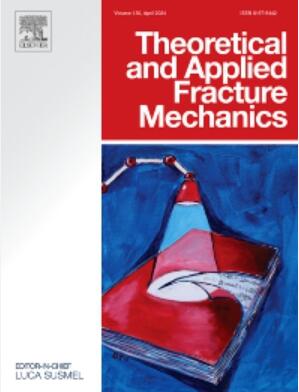超高性能纤维增强混凝土开裂后的缺口敏感性研究
IF 5
2区 工程技术
Q1 ENGINEERING, MECHANICAL
引用次数: 0
摘要
本研究的重点是通过广泛的数值和分析方法,研究结构尺寸效应和预缺口对超高性能纤维增强混凝土(UHPFRC)开裂后行为的影响。UHPFRC的延性主要由纤维桥接作用决定,与传统混凝土相比,纤维桥接作用会导致更宽的非线性非弹性损伤区。这种非线性非弹性损伤区长度被认为是确定名义应力和表征开裂后拉伸行为的关键参数。它对准脆性材料的尺寸效应行为有重要的控制作用。因此,本研究将非线性非弹性损伤区长度的影响纳入边界效应模型。推导出的公式同时考虑了UHPFRC峰后区域的峰值负荷点(PPeak)和第二个局部峰值负荷点(PMOR)。考虑75 mm、150 mm和300 mm三种不同的梁试件,在跨深比为2.5的条件下,建立了非线性非弹性损伤区长度的数学模型。缺口深度在0.1到0.27之间变化。在此范围内,小、中、大试件的峰值载荷归一化非线性非弹性损伤区长度(lp/D)分别在0.2-0.23、0.25-0.29和0.33-0.4之间变化。校正后的数值结果与实验和分析结果具有良好的相关性。进一步,基于导出公式的参数敏感性分析,发现试件尺寸和非线性非弹性损伤区长度的影响显著大于其他参数。本文章由计算机程序翻译,如有差异,请以英文原文为准。
Notch sensitivity on post-cracking behaviour of ultra-high performance fibre-reinforced concrete
The present study focuses on investigating the influence of structural size effect and pre-notch on post-cracking behaviour through extensive numerical and analytical approaches for ultra-high performance fibre-reinforced concrete (UHPFRC). The ductility of UHPFRC is primarily governed by the fibre bridging action that leads to a wider nonlinear inelastic damage zone compared to conventional concrete. This nonlinear inelastic damage zone length is considered as a critical parameter in determining the nominal stress and characterizing the post-cracking tensile behaviour. It significantly governs the size effect behaviour in quasi-brittle materials. Therefore, the proposed study incorporates the effect of nonlinear inelastic damage zone length into the boundary effect model (BEM). The derived formulations consider both the peak load point () and the second local peak load point () in the post-peak region of UHPFRC. A mathematical model for nonlinear inelastic damage zone length has been derived considering three different beam specimens of 75 mm, 150 mm, and 300 mm, having span-to-depth ratio as 2.5. Notch-depth has been varied between 0.1 to 0.27. Within this range, normalized nonlinear inelastic damage zone length at peak load (/) has been observed to vary between 0.2–0.23, 0.25–0.29, and 0.33–0.4 for small, medium, and large specimens, respectively. The calibrated numerical results show a good correlation with experimental and analytical outcomes. Further, based on parameter sensitivity analysis on derived formulation, the specimen size and the length of the nonlinear inelastic damage zone length have been found to be significantly more influential than other parameters.
求助全文
通过发布文献求助,成功后即可免费获取论文全文。
去求助
来源期刊

Theoretical and Applied Fracture Mechanics
工程技术-工程:机械
CiteScore
8.40
自引率
18.90%
发文量
435
审稿时长
37 days
期刊介绍:
Theoretical and Applied Fracture Mechanics'' aims & scopes have been re-designed to cover both the theoretical, applied, and numerical aspects associated with those cracking related phenomena taking place, at a micro-, meso-, and macroscopic level, in materials/components/structures of any kind.
The journal aims to cover the cracking/mechanical behaviour of materials/components/structures in those situations involving both time-independent and time-dependent system of external forces/moments (such as, for instance, quasi-static, impulsive, impact, blasting, creep, contact, and fatigue loading). Since, under the above circumstances, the mechanical behaviour of cracked materials/components/structures is also affected by the environmental conditions, the journal would consider also those theoretical/experimental research works investigating the effect of external variables such as, for instance, the effect of corrosive environments as well as of high/low-temperature.
 求助内容:
求助内容: 应助结果提醒方式:
应助结果提醒方式:


